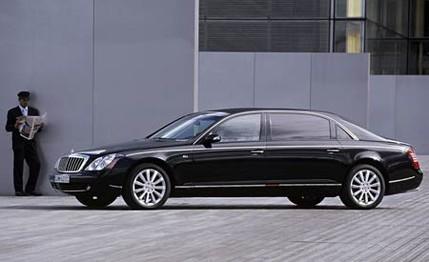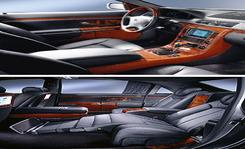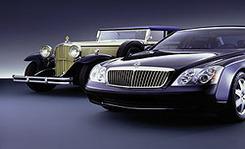
 First Drive Review
First Drive Review
Every so often, along comes a car so stunning you never want to go back to road-testing the Nissan Murano versus the Honda Pilot or comparing this BMW with that Lexus. Case in point, the new Maybach -- simply the finest, most spectacular, most technologically advanced, best-performing four-door passenger vehicle that has ever lightly dented the planet's surface. No contest. Game over. Pay up.
When DaimlerChrysler set out to preempt BMW's and Volkswagen's forays into the super-luxury-car market with German versions of the Rolls-Royce and Bentley brands they now own, there was little doubt that Mercedes engineers assigned to the task would blitzkrieg the category. And with 542 horsepower and 664 pound-feet of torque, the Maybach's twin-turbo V-12 makes this three-ton car quicker and faster than a Porsche 911 with Tiptronic. Okay, the Maybach is electronically limited to 155 mph, although on the autobahn we twice saw an indicated 163, but the monster is said to have done 185 without the limiter.
"The Maybach" is in fact two cars -- one of them huge, the other freakin' enormous. The Maybach 57 is 18.8 feet long, and the 62 runs just over 20 feet. (A Cadillac Escalade EXT totals just 18.5 feet.) The 62 is intended to be a chauffeur-driven limousine, and the extra length allows for a pair of NBA-friendly rear passenger seats that recline to about a 30-degrees-from-horizontal angle with leg rests that extend at the same slope.


We didn't drive the 62 -- what's the point? -- but instead rode in back for several hours and played with the passenger toys: A champagne refrigerator and twin flute holders. A coffee-table-size electroluminescent panel in the roof that can be set at anything from opaque to clear. Flat-screen monitors in the front seatbacks through which all the car's functions other than the actual driving can be controlled, plus TV and DVD viewing. A pair of wireless surround-sound headsets -- the world's first -- so two passengers can listen to entirely different audio or video programs.
We'll get the 62 out of the way by telling you that the van-size rear doors swing out so far they're well out of reach of the seated passengers and need to be shut by either an attentive chauffeur or a switch on the roof. That the strangely padded headrests feel like pillowing your head on a fat puppy. That the thing moves through autobahn traffic like a dreadnought steaming through a fishing fleet, its engine room a distant hum at flank speed, the sound of traffic barely penetrating the thick, double-pane windows. And that you want to be sure and unrecline the seats before the driver pops around and opens your door, or debarking is about as graceful as a drunk falling out of bed.
The 57, however, is actually a driver's car. Perhaps not the ideal choice for autocrossing, but a prototype has lapped the Nürburgring Nordschleife faster than the best-ever time of a production Porsche Boxster S. After you've ridden behind a chauffeur schooled in don't-spill-the-boss's-drink driving techniques, stepping fully into the 57's throttle yourself for the first time is literally breathtaking. The seamless, immediate rush of power is almost frightening, in part because it is upon you so silently. The engine speaks for itself and doesn't need tailpipe music to make its point.


If this boat were just an autobahn mile grinder, it wouldn't be of much interest to enthusiasts. Yet carving through tiny Bavarian towns on twisting lane-and-a-half roads can be pure fun, particularly as you watch the Germans in Audis you've shouldered aside mouth "Maybach!" as you boom past. The steering is precise and nicely weighted -- there's even a separate little steering-fluid radiator up front -- despite the heavy lifting it has to do, and the car's poise in corners makes you think it has the CL/SL-class active suspension. It doesn't -- that system uses hydraulics working steel springing members rather than the Maybach's air suspension -- but the air pressure at all four corners is constantly adjusted electronically for a semiactive suspension effect.